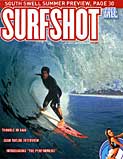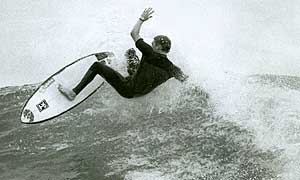SURFSHOT MAGAZINE, MAY 2004 It’s a lucky surfer that at one time or another has not experienced back pain. Approximately 70 to 90 percent of our population suffers with low back pain. Back pain is a complex problem that can be brought on by several factors such as age, lifestyle, diet, dehydration, stress, daily living activity or a sports related injury.
Surfing in itself can be very healthy for the back if you are physically prepared and have proper paddling technique. A way surfers can develop back problems is when they stop surfing on a consistent level. Becoming deconditioned will increase the risk of back injury. If you can only surf one or two weekends a month, then you’ll have to maintain a program that consists of flexibility, strength and cardio conditioning, so that when you do go surfing it won’t feel like it’s “too much too fast.”
Shea Parton showcasing a healthy layback snap. Photo: Kurt Jones.Even young and active surfers can injure their backs with high performance movements and overuse injuries. Though young surfers might squirm at the idea of exercise that doesn’t consist of catching a wave, they would be even more miserable if an injury kept them out of the water. Flexibility, cross training and core conditioning will keep the body in balance. A body out of balance has a high probability of injury.
Here are three common types of back injuries:
- Lumbar disc derangement is commonly known as a “slipped disc”. This occurs when the center (nucleus) of the disc begins to bulge out against the surrounding fiber (annulus fibrosis). The level of pain and discomfort depends on which of four stages of disc derangement one has. Movements involving forward flexion and rotation like surfing often cause it, and it is seen in people ages 20-50. Doing back extension exercises is good for this condition.
- Ankylosed spondylitis is a defect in the area between the vertebra facets called pars interasticularis. It can be genetic or caused by forceful hyperextension. It is typically seen in individuals between 20-30 but can also occur in young athletes active in explosive sports like gymnastics, tennis, diving, football, ice hockey and surfing. Back extension exercises are very painful and not to be performed under this condition.
- Spinal stenosis is the narrowing of the spinal canal, which contains and protects the spinal cord and nerve roots. The result is low back pain and perhaps leg pain. Stenosis can be acquired from wear and tear, faulty loading or can be congenital. It is often seen in individuals over 50 years old with past back injuries. Forward flexation exercises are good for this condition.
If you suffer from back pain go to a health practitioner who can design a functional exercise program that takes into consideration your body as a whole. A program that addresses movement, posture, flexibility and musculoskeletal deficiencies can be found at the Chek Institute at (760) 477-2620 or www.chekinstitute.com.
In health and fitness,
Paul Frediani
www.surfflex.comSend us your surf health question to editor@surfshot.com and Paul will answer them. Selected questions will win a copy of this great book!



